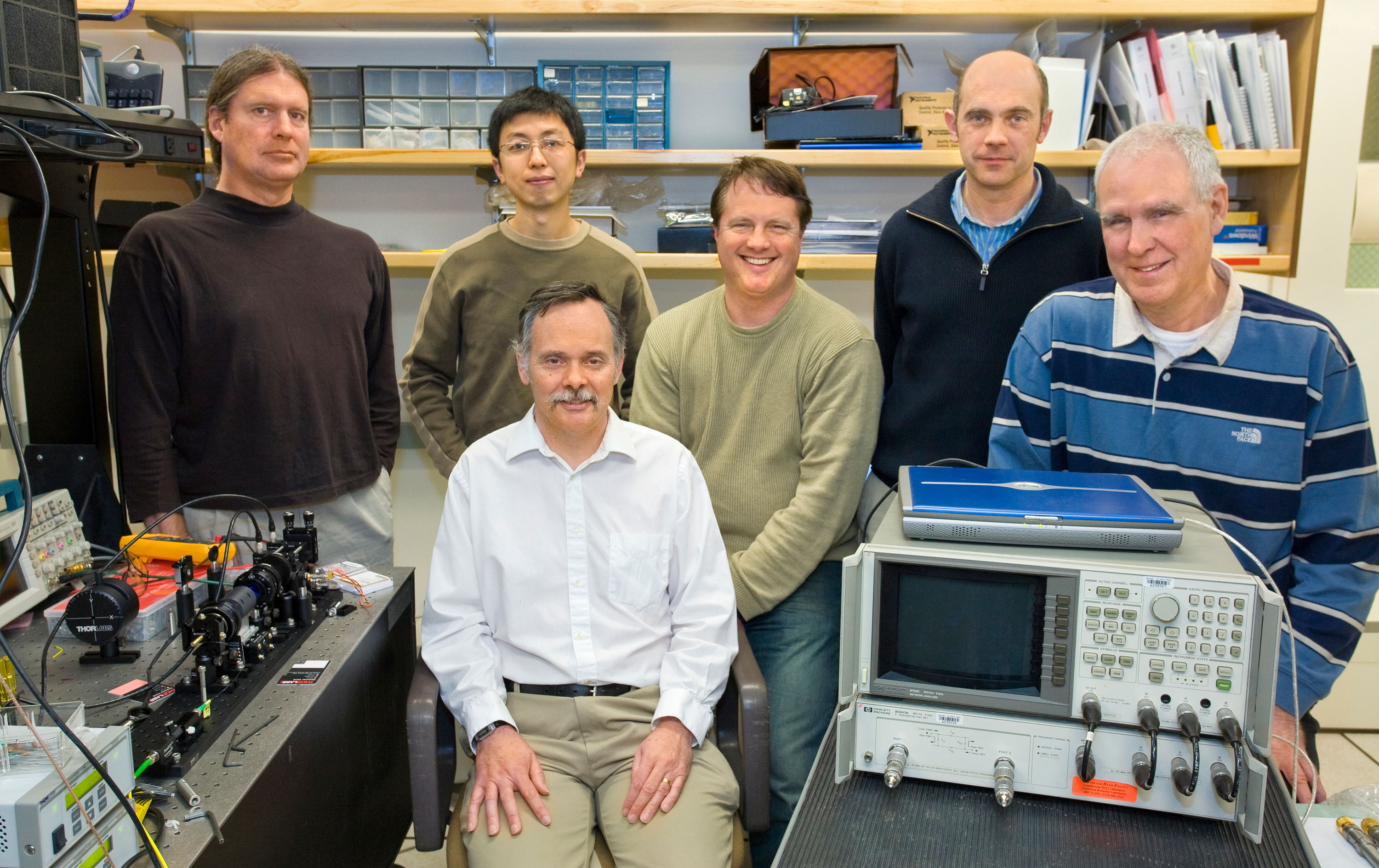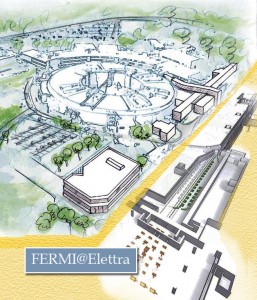Contact: Paul Preuss, (510) 486-6249, [email protected]
Under a two-year contract, Berkeley Lab scientists and engineers in the Center for Beam Optics will provide high-precision synchronization and control for the linacs, or linear accelerator sections, of FERMI@Elettra, the next-generation free electron laser (FEL) now under construction at the Elettra synchrotron light source in Trieste, Italy.
What makes synchronization critical to the success of future accelerator- and laser-based light sources is the dramatically shrinking time scale at which the new machines and their experiments must operate. Components separated by up to a kilometer or more must be synchronized to within 10 to 1,000 femtoseconds, a very tiny slice of time: a femtosecond is a mere quadrillionth of a second (10-15 second); there are as many femtoseconds in one second as there are seconds in 32 billion years.
Or, as project leader John Byrd of the Accelerator and Fusion Research Division (AFRD) says, pinching his fingers tightly together, “in 100 femtoseconds light travels about this far.”
Byrd says that the FERMI@Elettra project is the second major application of unique timing and stabilization methods developed by the Center for Beam Physics, “the first being for Stanford’s Linac Coherent Light Source. We’re good at lots of things, but synchronization is an area where we’ve developed special expertise.”
Basic research for timing systems was originally supported by Laboratory Directed Research and Development funds to the tune of a few hundred thousand dollars, so Byrd says the Linac Coherent Light Source (LCLS) and FERMI@Elettra contracts, totaling some $3 million, constitute a significant return on investment. “But that’s not what really drives the excitement,” he says.
“The end game is to provide a timing system for Berkeley Lab’s Advanced Photon Science Initiative, which we hope will result in a linac-based, multiple-FEL light source here on the Hill,” says Byrd. “From linacs to lasers to experiments, we want our synchronization system to be the conductor for the whole orchestra.”
Bringing the pieces together
Two separate systems are brought together in the planned synchronization system for FERMI@Elettra. The first is an advanced digital RF controller, based on a successful control method devised by Berkeley Lab scientist and engineers for the superconducting linear accelerator at the Spallation Neutron Source (SNS) at Oak Ridge National Laboratory.
Accelerators have long used RF (radio frequency) cavities to accelerate their beams. In each cavity a standing electromagnetic wave creates a gradient electric field, which boosts the energy of charged particles passing through the cavity. Successful acceleration requires that the phase of the wave in each cavity be synchronized to the moment the particles enter; otherwise they will be only weakly accelerated, or not affected at all, or even slowed down.
The digital RF controllers devised by Engineering’s Larry Doolittle for the SNS demonstrated 0.1 percent amplitude stability and a mere 0.1 degree in phase stability – that is, they matched phase to within a tenth of the full rise-fall-rise cycle of each wave. But performance for FERMI@Elettra must be an order of magnitude better.
“Each accelerating cavity in FERMI@Elettra’s two linacs will be controlled by a customized, dedicated, digital low-level RF controller,” Byrd says. “The key to these devices is something called a field-programmable gate array, or FPGA. FPGAs can be made very application-specific; you can program the arrays to any format you want, for example a computer’s CPU.”
By conforming the input, output, and processing of signals specific to linear accelerators, lasers, and the machine’s housekeeping components onto the FPGAs, the RF controllers for FERMI@Elettra will be able to stabilize the phase of the electromagnetic wave in each cavity to less than .01 degree, at a frequency of 3 gigahertz (3 billion cycles per second) – matching phase to within a hundredth of a single cycle.
“Essentially the controller concentrates a huge amount of built-in computer power on the task of synchronizing the exact phase of the wave in each accelerating cavity with all the other controllers,” Byrd says.
A femtosecond-scale master clock
The second of the two methods to be combined in the FERMI@Elettra timing and synchronization system is a stabilized optical link, which will provide a master clock based on a tightly controlled RF signal for all segments of the accelerators, FELs, and experiments.
Developed by AFRD’s John Staples and the Engineering Division’s Russell Wilcox, the unique fiber-optic system was developed partly because conventional coaxial cables are too temperature-sensitive to maintain accurate 100-femtosecond timing beyond a distance of 100 meters. When the length of a cable changes because of expansion or contraction in response to changing temperature, the time it takes for a signal to travel along it from one place to another changes as well.
Fiber optics are sensitive too, of course. “Optical fibers are affected by heat, noise, vibration,” says Byrd, “and if you’re trying to provide timing signals of less than 100 femtoseconds, just blowing on the system will introduce errors.” But fiber optics has major advantages, as Staples and Wilcox realized.
They monitor and adjust for changes in the length the timing signals must travel by using interferometry, the same remarkably simple (in principle) technique invented by the pioneering physicist Albert Michelson in 1881. A signal from a frequency-stabilized laser is sent over the transmission arm of the system, the “long arm,” and when reflected back is compared to a reference signal in the “short arm,” a signal split from the same original laser beam.

Among the members of the Accelerator and Fusion Research Division and Engineering Division whose extensive experience at the Spallation Neutron Source, the Linac Coherent Light Source, and other facilities have contributed to the FERMI@Elettra timing and synchronization systems are (from left) Russell Wilcox, Gang Huang, Larry Doolittle, John Byrd, Alex Ratti, and John Staples. (Photo Roy Kaltschmidt)
Any difference in the phase of the two signals is measured by an RF controller, which compensates by adjusting the length of the long arm, either in small, quick increments by a phase-shifting piezoelectric crystal, or by a slower, motor-driven optical line stretcher that operates over longer distance. By keeping the return and reference signals in phase, the system maintains a precise time reference throughout the entire span of the complex.
This timing system has already been successfully installed at the Linac Coherent Light Source, which uses a kilometer-long portion of the SLAC linear accelerator to produce pulsed femtosecond-scale bunches of x-ray photons. For the FERMI@Elettra system, the last big step is to bring the fiber-optic and RF control systems together.
A prototype of the combined RF control and fiber-optic timing and synchronization system will be built and installed at Elettra’s existing linac, where it will be used to measure the linac’s performance. The results will be used to design the final architecture for FERMI@Elettra in partnership with Sincrotrone Trieste, which manages the facility.
“The performance of the FERMI@Elettra free electron laser will depend critically on maintaining the relative phase of its accelerating sections to within 50 to 200 femtoseconds,” says Byrd. “No system that can do this has ever been demonstrated outside the laboratory. But we have built components of such a system in working environments like the SNS and the LCLS, and we look forward to combining these in a new technological application to enable FERMI@Elettra to achieve its ambitious scientific goals.”
Additional information
More about FERMI@Elettra is at http://www.elettra.trieste.it/FERMI/ and at http://www.lbl.gov/today/2006/Aug/04-Fri/Elettra_pdf_FINAL.pdf
More about the timing system for Stanford’s LCLS is at http://www.lbl.gov/today/2008/Apr/01-Tue/timing-jump.html
More about digital RF controllers is at Larry Doolittle’s website at http://recycle.lbl.gov/~ldoolitt/llrf/
More about the fiber-optic timing system devised by John Staples and Russell Wilcox is at http://www.lbl.gov/Science-Articles/Archive/sabl/2007/Jun/nSync.html
More about the Advanced Photon Initiative is at http://newscenter.lbl.gov/feature-stories/2007/11/14/into-the-future-at-the-speed-of-light/
